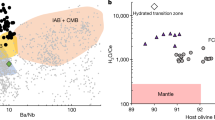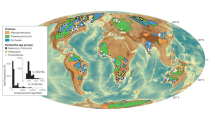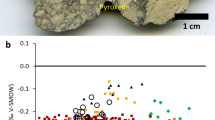Abstract
Archaean komatiites (ultramafic lavas) result from melting under extreme conditions of the Earth’s mantle. Their chemical compositions evoke very high eruption temperatures, up to 1,600 degrees Celsius, which suggests even higher temperatures in their mantle source1,2. This message is clouded, however, by uncertainty about the water content in komatiite magmas. One school of thought holds that komatiites were essentially dry and originated in mantle plumes3,4,5,6 while another argues that these magmas contained several per cent water, which drastically reduced their eruption temperature and links them to subduction processes7,8,9. Here we report measurements of the content of water and other volatile components, and of major and trace elements in melt inclusions in exceptionally magnesian olivine (up to 94.5 mole per cent forsterite). This information provides direct estimates of the composition and crystallization temperature of the parental melts of Archaean komatiites. We show that the parental melt for 2.7-billion-year-old komatiites from the Abitibi greenstone belt in Canada contained 30 per cent magnesium oxide and 0.6 per cent water by weight, and was depleted in highly incompatible elements. This melt began to crystallize at around 1,530 degrees Celsius at shallow depth and under reducing conditions, and it evolved via fractional crystallization of olivine, accompanied by minor crustal assimilation. As its major- and trace-element composition and low oxygen fugacities are inconsistent with a subduction setting, we propose that its high H2O/Ce ratio (over 6,000) resulted from entrainment into the komatiite source of hydrous material from the mantle transition zone10. These results confirm a plume origin for komatiites and high Archaean mantle temperatures, and evoke a hydrous reservoir in the deep mantle early in Earth’s history.
This is a preview of subscription content, access via your institution
Access options
Subscribe to this journal
Receive 51 print issues and online access
$199.00 per year
only $3.90 per issue
Buy this article
- Purchase on Springer Link
- Instant access to full article PDF
Prices may be subject to local taxes which are calculated during checkout




Similar content being viewed by others
References
Herzberg, C. Depth and degree of melting of komatiites. J. Geophys. Res. Solid Earth 97, 4521–4540 (1992)
Nisbet, E. G., Cheadle, M. J., Arndt, N. T. & Bickle, M. J. Constraining the potential temperature of the Archean mantle—a review of the evidence from komatiites. Lithos 30, 291–307 (1993)
Arndt, N. et al. Were komatiites wet? Geology 26, 739–742 (1998)
Campbell, I. H., Griffiths, R. W. & Hill, R. I. Melting in an Archean mantle plume—heads it’s basalts, tails it’s komatiites. Nature 339, 697–699 (1989)
Herzberg, C. et al. Temperatures in ambient mantle and plumes: constraints from basalts, picrites, and komatiites. Geochem. Geophys. Geosyst. 8, Q02006 (2007)
McDonough, W. F. & Ireland, T. R. Intraplate origin of komatiites inferred from trace-elements in glass inclusions. Nature 365, 432–434 (1993)
Allègre, C. J. in Komatiites (eds Arndt, N. T. & Nisbet, E. G. ) 495–500 (George Allen and Unwin, 1982)
Grove, T. L. & Parman, S. W. Thermal evolution of the Earth as recorded by komatiites. Earth Planet. Sci. Lett. 219, 173–187 (2004)
Parman, S. W., Grove, T. L., Dann, J. C. & de Wit, M. J. A subduction origin for komatiites and cratonic lithospheric mantle. S. Afr. J. Geol. 107, 107–118 (2004)
Bercovici, D. & Karato, S. Whole-mantle convection and the transition-zone water filter. Nature 425, 39–44 (2003)
Lahaye, Y. & Arndt, N. Alteration of a komatiite flow from Alexo, Ontario, Canada. J. Petrol. 37, 1261–1284 (1996)
Pyke, D. R., Naldrett, A. J. & Eckstrand, O. R. Archean ultramafic flows in Munro township, Ontario. Geol. Soc. Am. Bull. 84, 955–977 (1973)
Puchtel, I. S., Walker, R. J., Brandon, A. D. & Nisbet, E. G. Pt-Re-Os and Sm-Nd isotope and HSE and REE systematics of the 2.7 Ga Belingwe and Abitibi komatiites. Geochim. Cosmochim. Acta 73, 6367–6389 (2009)
Kamenetsky, V. S., Sobolev, A. V., Eggins, S. M., Crawford, A. J. & Arculus, R. J. Olivine-enriched melt inclusions in chromites from low-Ca boninites, Cape Vogel, Papua New Guinea: evidence for ultramafic primary magma, refractory mantle source and enriched components. Chem. Geol. 183, 287–303 (2002)
Portnyagin, M., Almeev, R., Matveev, S. & Holtz, F. Experimental evidence for rapid water exchange between melt inclusions in olivine and host magma. Earth Planet. Sci. Lett. 272, 541–552 (2008)
Lahaye, Y., Barnes, S. J., Frick, L. R. & Lambert, D. D. Re-Os isotopic study of komatiitic volcanism and magmatic sulfide formation in the southern Abitibi greenstone belt, Ontario, Canada. Can. Mineral. 39, 473–490 (2001)
Evans, K. A., Elburg, M. A. & Kamenetsky, V. Oxidation state of subarc mantle. Geology 40, 783–786 (2012)
Kent, A. J. R., Norman, M. D., Hutcheon, I. D. & Stolper, E. M. Assimilation of seawater-derived components in an oceanic volcano: evidence from matrix glasses and glass inclusions from Loihi seamount, Hawaii. Chem. Geol. 156, 299–319 (1999)
Gurenko, A. A. & Kamenetsky, V. S. Boron isotopic composition of olivine-hosted melt inclusions from Gorgona komatiites, Colombia: new evidence supporting wet komatiite origin. Earth Planet. Sci. Lett. 312, 201–212 (2011)
Ford, C. E., Russell, D. G., Craven, J. A. & Fisk, M. R. Olivine liquid equilibria—temperature, pressure and composition dependence of the crystal liquid cation partition coefficients for Mg, Fe2+, Ca and Mn. J. Petrol. 24, 256–266 (1983)
Herzberg, C. & O'Hara, M. J. Plume-associated ultramafic magmas of phanerozoic age. J. Petrol. 43, 1857–1883 (2002)
Herzberg, C. & Asimow, P. D. PRIMELT3 MEGA.XLSM software for primary magma calculation: peridotite primary magma MgO contents from the liquidus to the solidus. Geochem. Geophys. Geosyst. 16, 563–578 (2015)
Herzberg, C., Condie, K. & Korenaga, J. Thermal history of the Earth and its petrological expression. Earth Planet. Sci. Lett. 292, 79–88 (2010)
Herzberg, C. & Gazel, E. Petrological evidence for secular cooling in mantle plumes. Nature 458, 619–622 (2009)
Dixon, J. E., Leist, L., Langmuir, C. & Schilling, J. G. Recycled dehydrated lithosphere observed in plume-influenced mid-ocean-ridge basalt. Nature 420, 385–389 (2002)
Mibe, K., Orihashi, Y., Nakai, S. i. & Fujii, T. Element partitioning between transition-zone minerals and ultramafic melt under hydrous conditions. Geophys. Res. Lett. 33, L16307 (2006)
Roberge, M. et al. Is the transition zone a deep reservoir for fluorine? Earth Planet. Sci. Lett. 429, 25–32 (2015)
Pearson, D. G. et al. Hydrous mantle transition zone indicated by ringwoodite included within diamond. Nature 507, 221–224 (2014)
Albarède, F. Volatile accretion history of the terrestrial planets and dynamic implications. Nature 461, 1227–1233 (2009)
Falloon, T. J. & Danyushevsky, L. V. Melting of refractory mantle at 1.5, 2 and 2.5 GPa under, anhydrous and H2O-undersaturated conditions: implications for the petrogenesis of high-Ca boninites and the influence of subduction components on mantle melting. J. Petrol. 41, 257–283 (2000)
Ribeiro, J. M. et al. Composition of the slab-derived fluids released beneath the Mariana forearc: evidence for shallow dehydration of the subducting plate. Earth Planet. Sci. Lett. 418, 136–148 (2015)
Hofmann, A. W. Chemical differentiation of the Earth: the relationship between mantle, continental crust, and oceanic crust. Earth Planet. Sci. Lett. 90, 297–314 (1988)
Walter, M. J. Melting of garnet peridotite and the origin of komatiite and depleted lithosphere. J. Petrol. 39, 29–60 (1998)
Sobolev, A. V. et al. The amount of recycled crust in sources of mantle-derived melts. Science 316, 412–417 (2007)
Batanova, V. G., Sobolev, A. V. & Kuzmin, D. V. Trace element analysis of olivine: high precision analytical method for JEOL JXA-8230 electron probe microanalyser. Chem. Geol. 419, 149–157 (2015)
Jochum, K. P. et al. MPI-DING reference glasses for in situ microanalysis: new reference values for element concentrations and isotope ratios. Geochem. Geophys. Geosyst. 7, Q02008 (2006)
Batanova, V. G., Belousov, I. A., Savelieva, G. N. & Sobolev, A. V. Consequences of channelized and diffuse melt transport in supra-subduction mantle: evidence from Voykar ophiolite (Polar Urals). J. Petrol. 52, 2483–2521 (2011)
Rosner, M. & Meixner, A. Boron isotopic composition and concentration of ten geological reference materials. Geostand. Geoanal. Res. 28, 431–441 (2004)
Spivack, A. J. & Edmond, J. M. Determination of boron isotope ratios by thermal ionization mass-spectrometry of the dicesium metaborate cation. Anal. Chem. 58, 31–35 (1986)
Sobolev, A. V. & Danyushevsky, L. V. Petrology and geochemistry of boninites from the North termination of the Tonga trench–constraints on the generation conditions of primary high-Ca boninite magmas. J. Petrol. 35, 1183–1211 (1994)
Wallace, P. J., Kamenetsky, V. S. & Cervantes, P. Melt inclusion CO2 contents, pressures of olivine crystallization, and the problem of shrinkage bubbles. Am. Mineral. 100, 787–794 (2015)
Mironov, N. et al. Quantification of the CO2 budget and H2O–CO2 systematics in subduction-zone magmas through the experimental hydration of melt inclusions in olivine at high H2O pressure. Earth Planet. Sci. Lett. 425, 1–11 (2015)
Danyushevsky, L. V., Sokolov, S. & Falloon, T. J. Melt inclusions in olivine phenocrysts: using diffusive re-equilibration to determine the cooling history of a crystal, with implications for the origin of olivine-phyric volcanic rocks. J. Petrol. 43, 1651–1671 (2002)
Danyushevsky, L. V. & Plechov, P. Petrolog3: integrated software for modeling crystallization processes. Geochem. Geophys. Geosyst. 12, Q07021 (2011)
Brown, P. E. FLINCOR: a microcomputer program for the reduction and investigation of fluid-inclusion data. Am. Mineral. 74, 1390–1393 (1989)
Newman, S. & Lowenstern, J. B. VOLATILECALC: a silicate melt-H2O-CO2 solution model written in Visual Basic for Excel. Comput. Geosci. 28, 597–604 (2002)
Mallmann, G. & O'Neill, H. S. Calibration of an empirical thermometer and oxybarometer based on the partitioning of Sc, Y and V between olivine and silicate melt. J. Petrol. 54, 933–949 (2013)
Coogan, L. A., Saunders, A. D. & Wilson, R. N. Aluminum-in-olivine thermometry of primitive basalts: evidence of an anomalously hot mantle source for large igneous provinces. Chem. Geol. 368, 1–10 (2014)
Médard, E. & Grove, T. L. The effect of H2O on the olivine liquidus of basaltic melts: experiments and thermodynamic models. Contrib. Mineral. Petrol. 155, 417–432 (2008)
Almeev, R. R., Holtz, F., Koepke, J., Parat, F. & Botcharnikov, R. E. The effect of H2O on olivine crystallization in MORB: experimental calibration at 200 MPa. Am. Mineral. 92, 670–674 (2007)
Fan, J. & Kerrich, R. Geochemical characteristics of aluminum depleted and undepleted komatiites and HREE-enriched low-Ti tholeiites, Western Abitibi greenstone belt: A heterogeneous mantle plume convergent margin environment. Geochim. Cosmochim. Acta. 61, 4723–4744 (1997)
Mallmann, G. & O’Neill, H. S. C. The crystal/melt partitioning of V during mantle melting as a function of oxygen fugacity compared with some other elements (Al, P, Ca, Sc, Ti, Cr, Fe, Ga, Y, Zr and Nb). J. Petrol. 50, 1765–1794 (2009)
Acknowledgements
We thank A. Kadik, A. Borisov and A. Kargal’tsev for their assistance in high-temperature experiments, V. Magnin for assistance in maintenance of the EPMA laboratory, U. Westernströer for help with laser-ablation ICP-MS measurements, and V. Kamenetsky for providing sample 41F of the Cape Vogel boninites. The paper benefited greatly from the constructive reviews of C. Herzberg and I. Puchtel and the comments of S. Sobolev. This study was funded by the Russian Science Foundation grant number 14-17-00491 (to A.V.S.). The EPMA facility in ISTerre was established and maintained by funds of the Agence Nationale de la Recherche, France, the Chair of Excellence grant ANR-09-CEXC-003-01 and partly by CNRS and Labex OSUG@2020 (Investissements d’avenir—ANR10 LABX56). A.V.S. acknowledges the support of Institut Universitaire de France and the Deep Carbon Observatory. The costs of SIMS analyses were covered by CRPG (A.A.G.’s internal funds). This is CRPG contribution number 2430.
Author information
Authors and Affiliations
Contributions
A.V.S. designed the study, participated in sample collection, data processing and interpretation, and wrote the paper. E.V.A. participated in sample collection, found and prepared melt inclusions in olivines, conducted EPMA analyses and participated in the data processing and interpretation. A.A.G. performed SIMS analyses and participated in data interpretation and writing the paper. N.T.A. led the field work and sample collection, participated in data interpretation and co-authored the paper. V.G.B. managed the EPMA analyses. M.V.P. performed the laser-ablation ICP-MS analyses and participated in data interpretation and writing the paper. D.G.-S. managed the laser-ablation ICP-MS analyses. S.P.K. conducted the heating experiments. All authors discussed the results, problems or methods and participated in preparation of the paper.
Corresponding author
Ethics declarations
Competing interests
The authors declare no competing financial interests.
Additional information
A copy of the Supplementary Information has been submitted to Researchgate (https://www.researchgate.net/profile/Alexander_Sobolev) and GEOROC (http://georoc.mpch-mainz.gwdg.de/georoc/) databases.
Extended data figures and tables
Extended Data Figure 1 Melt inclusions in olivine from Abitibi belt komatiites.
a, Back-scattered electron image of partly crystallized (unheated) melt inclusion 823-th-ol8 in olivine (ol) of Alexo flow sample M823. The inclusion is composed of glass, quenched clinopyroxene (cpx), spinel (spl) and gas bubble. b, Heated and quenched melt inclusion (810-7-ol1) in olivine from Pyke Hill komatiite sample M810. The inclusion contains glass, gas bubble and spinel. c, Heated and quenched melt inclusion (810-9-ol16) in olivine from Pyke Hill komatiite sample M810. The inclusion contains glass, gas bubble and spinel. d, Back-scattered electron image of the inclusion in c.
Supplementary information
Supplementary Tables
This file contains Supplementary Tables 1–5. This file was replaced on 31 March 2016 to correct a formatting error. Supplementary Table 4 was replaced on 6 June 2016 to correct typos in sample 823. (XLSX 203 kb)
Rights and permissions
About this article
Cite this article
Sobolev, A., Asafov, E., Gurenko, A. et al. Komatiites reveal a hydrous Archaean deep-mantle reservoir. Nature 531, 628–632 (2016). https://doi.org/10.1038/nature17152
Received:
Accepted:
Published:
Issue Date:
DOI: https://doi.org/10.1038/nature17152
This article is cited by
-
Earth’s early continental crust formed from wet and oxidizing arc magmas
Nature (2023)
-
Spinel-group minerals as a record of magmatic and metamorphic processes: evidence from the highly altered Morro do Onça ultramafic suite, São Francisco Craton (Brazil)
Contributions to Mineralogy and Petrology (2022)
-
The impact on mantle olivine resulting from carbonated silicate melt interaction
Contributions to Mineralogy and Petrology (2020)
-
Geochemistry of ultramafic–mafic rocks of Mesoarchean Sargur Group, western Dharwar craton, India: Implications for their petrogenesis and tectonic setting
Journal of Earth System Science (2020)
-
Deep hydrous mantle reservoir provides evidence for crustal recycling before 3.3 billion years ago
Nature (2019)
Comments
By submitting a comment you agree to abide by our Terms and Community Guidelines. If you find something abusive or that does not comply with our terms or guidelines please flag it as inappropriate.



